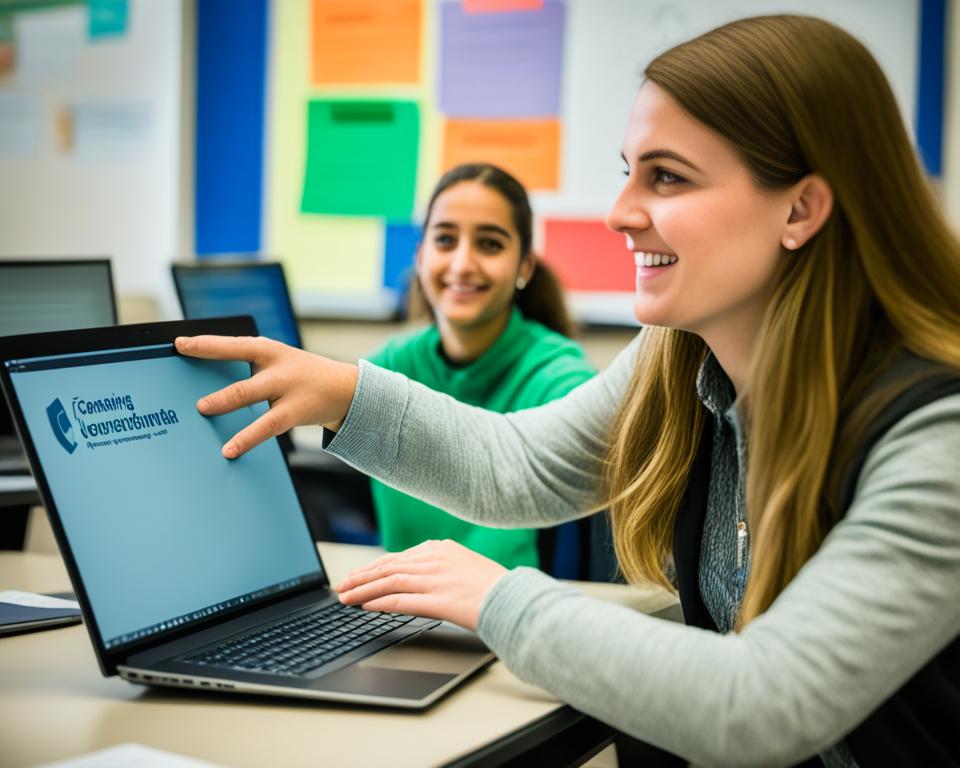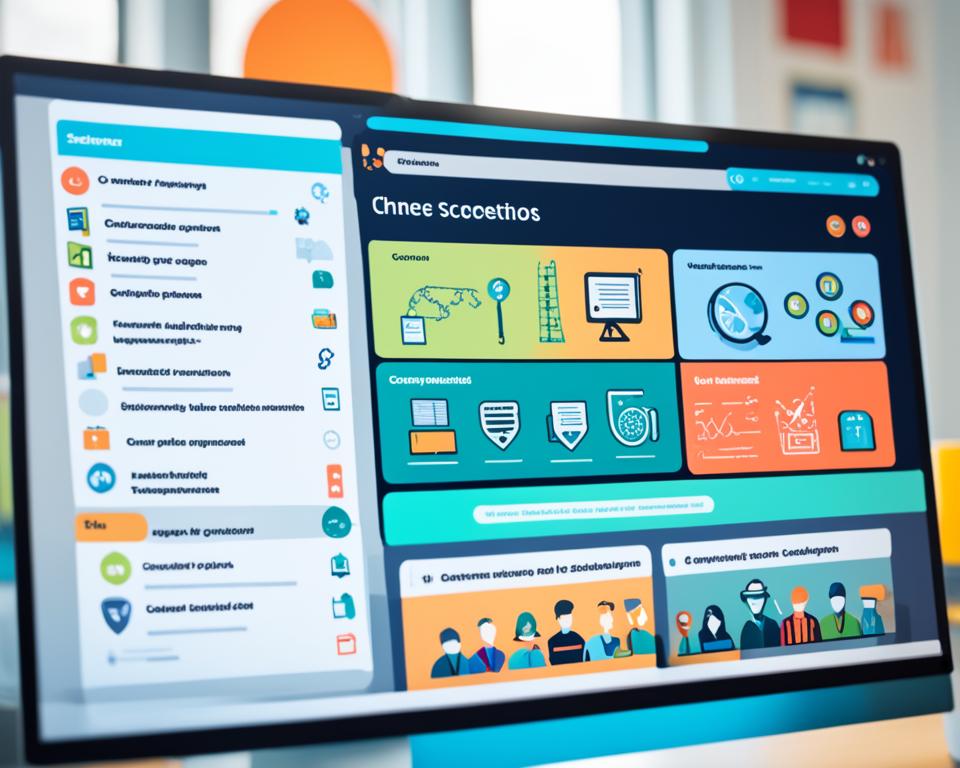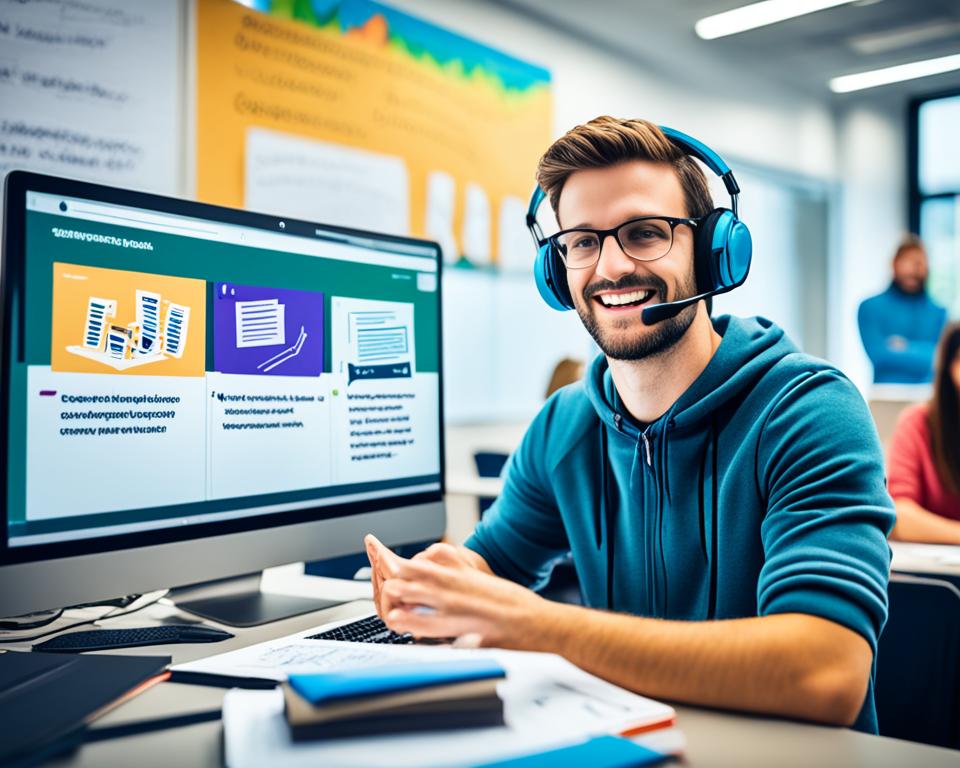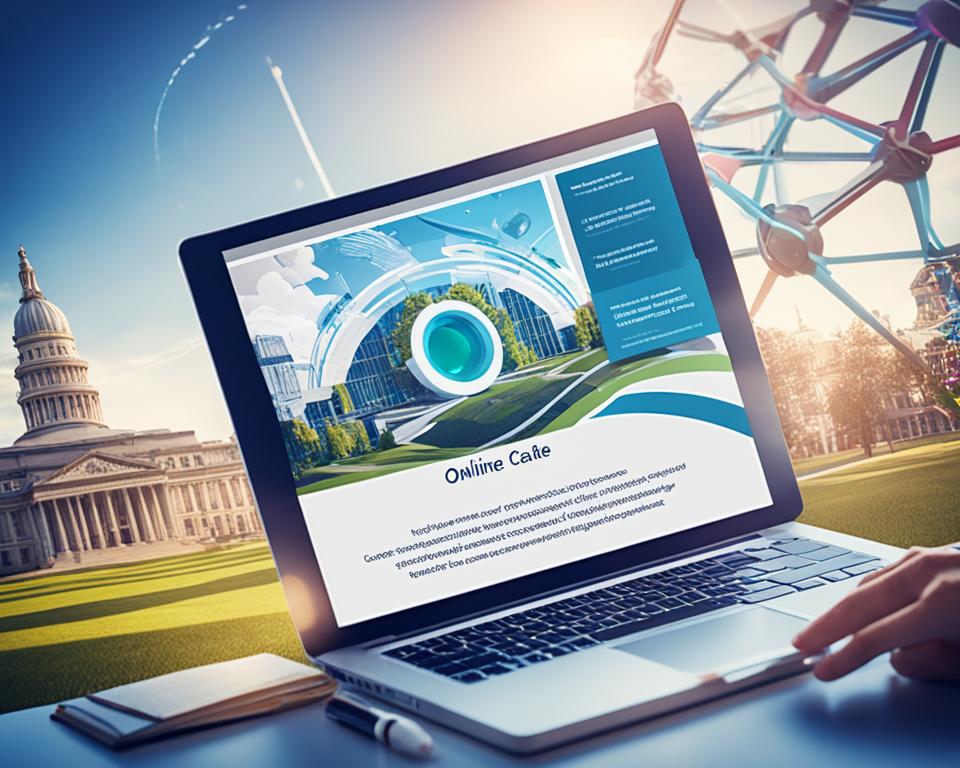Providing effective feedback and support to students in a remote learning environment can be challenging. In this article, we will explore various strategies and techniques to help educators provide timely and constructive feedback to their students in a virtual setting.
Key Takeaways:
- Implementing remote learning support strategies is crucial for supporting students in virtual classrooms.
- Online student feedback strategies play a vital role in guiding students’ progress and growth.
- Utilize digital tools and platforms to provide remote assistance and support to students.
- Creating open channels of communication and normalizing asking questions can foster a supportive learning environment.
- Consider the unique challenges and inequities faced by students in a remote learning environment and accommodate their diverse needs.
Types of Feedback
Feedback plays a crucial role in the learning process, helping students reflect on their progress and make improvements. There are different types of feedback that educators can provide to support students’ growth and development. These include:
- Formative Feedback: This type of feedback is given during the learning process to help students understand their strengths and weaknesses. It focuses on providing guidance and support to improve performance. Formative feedback can be given through various mediums such as written comments, audio recordings, or one-on-one discussions.
- Summative Feedback: Summative feedback is typically given at the end of a learning activity or assessment. It evaluates students’ overall performance and provides a summary of their achievements. This type of feedback helps students understand their final outcomes and areas for further improvement.
- Positive Feedback: Positive feedback emphasizes students’ accomplishments and strengths. It recognizes their efforts and motivates them to continue progressing. Positive feedback can boost students’ self-confidence and encourage them to push their boundaries.
- Constructive Feedback: Constructive feedback aims to provide suggestions for improvement. It focuses on specific areas where students can enhance their skills or knowledge. This type of feedback helps students recognize areas of growth and provides them with strategies to overcome challenges.
By offering a combination of formative, summative, positive, and constructive feedback, educators can provide comprehensive support to students and foster their ongoing development.
Benefits of Feedback
Feedback plays a crucial role in student learning and development, offering a wide range of benefits that contribute to their overall academic success. By providing timely and constructive feedback, educators can positively impact student motivation, confidence, engagement, and autonomy.
Boosting Confidence and Self-Efficacy
Feedback offers students an opportunity to recognize their accomplishments and strengths, reinforcing their confidence and self-belief. When students receive feedback that acknowledges their efforts and progress, they are more likely to feel confident in their abilities and motivated to continue their learning journey.
Linking Learning Goals to Interests and Aspirations
Effective feedback connects students’ learning goals to their interests and aspirations. By tailoring feedback to address their individual needs and aligning it with their passions, educators can foster a sense of relevance and personal connection to the material, motivating students to engage deeply in their studies.
Promoting Autonomy and Ownership
Constructive feedback empowers students to take ownership of their learning and become active participants in the educational process. By providing guidance and suggestions for improvement, educators encourage students to reflect on their performance, develop problem-solving skills, and take responsibility for their academic growth.
Enhancing Engagement and Persistence in Learning
Feedback plays a crucial role in keeping students engaged and motivated throughout their educational journey. By providing specific and actionable feedback, educators can help students understand their areas for improvement and develop strategies to overcome challenges. This targeted guidance fosters a sense of purpose and determination, promoting persistence and a growth mindset.
“When students receive feedback that acknowledges their efforts and progress, they are more likely to feel confident in their abilities and motivated to continue their learning journey.”
Overall, feedback serves as a catalyst for student success, stimulating motivation, enhancing confidence, fostering engagement, and nurturing their autonomy. By incorporating effective feedback strategies into their teaching practices, educators can create a supportive and empowering learning environment that promotes academic growth and achievement.

Challenges of Feedback
Providing feedback in a remote learning environment comes with its own set of challenges. Educators must navigate various obstacles to ensure that feedback is effective and impactful. This section explores some of the key challenges faced when giving feedback in a remote setting and offers strategies to overcome them.
Timely Feedback in an Asynchronous Environment
One major challenge of remote feedback is providing timely responses to students’ work. In a traditional classroom, teachers can provide immediate feedback during or after a lesson. However, in an asynchronous online learning environment, students submit assignments at different times, making it difficult for teachers to respond in a timely manner. This delay can hinder students’ progress and engagement.
To overcome this challenge, educators can establish clear expectations for feedback turnaround time and communicate them to students. Setting specific deadlines for feedback and sticking to them can help create accountability and ensure timely responses. Additionally, using automated feedback tools or pre-recorded video feedback can provide students with immediate guidance even in the absence of real-time interaction.
Conveying Tone and Intention in a Digital Format
Another challenge of remote feedback is accurately conveying tone and intention. Written feedback lacks the non-verbal cues present in face-to-face communication, making it challenging to express empathy, encouragement, or constructive criticism effectively.
To address this challenge, educators can incorporate audio or video feedback alongside written comments. Including verbal cues such as tone of voice and facial expressions can help clarify the intended message and ensure that students interpret feedback in the desired manner. Additionally, using emoticons or emojis sparingly can add a touch of emotion to written feedback.
“Audio and video feedback allows me to provide more nuanced responses to students, ensuring that they understand my intentions and feel supported throughout their learning journey.” – Jane Smith, High School Teacher
Managing Overwhelming Feedback from Multiple Sources
Remote learning often involves feedback from multiple sources, including teachers, peers, and self-assessment. While diverse feedback can be beneficial, managing and synthesizing the abundance of input can be overwhelming for students.
To address this challenge, educators can guide students on how to prioritize and process feedback effectively. This can include teaching them strategies to identify recurring themes or patterns in feedback, setting goals based on feedback, and encouraging self-reflection to develop metacognitive skills. By providing explicit guidance on how to use feedback, educators can help students make the most of the feedback they receive.
Dealing with Demotivating or Vague Feedback
Receiving demotivating or vague feedback can be discouraging for students and hinder their learning progress. Negative or unclear comments may leave students feeling frustrated and unsure about how to improve.
To address this challenge, educators should strive to provide specific, actionable feedback that highlights areas for improvement while also recognizing students’ strengths. Clear guidelines and rubrics can help ensure that feedback is focused and constructive. Furthermore, encouraging students to ask for clarification when feedback is unclear can promote a growth mindset and open lines of communication.
By being aware of these challenges and implementing strategies to overcome them, educators can provide effective feedback that supports students’ learning and growth in a remote learning environment.
Tools for Feedback
In order to provide effective feedback in a remote learning environment, educators have access to a range of tools and technologies. These tools can streamline the feedback process and enable teachers to provide timely and detailed feedback to their students. Here are some popular tools for feedback:
Google Forms
Google Forms is a versatile tool that allows educators to create surveys and quizzes for their students. It provides a user-friendly interface for creating feedback forms, which can be customized to suit different needs. With Google Forms, teachers can collect valuable feedback from students and gain insights into their understanding and learning progress.
Flipgrid
Flipgrid is a video discussion platform that enables students to share their ideas, thoughts, and projects through short video recordings. Teachers can use Flipgrid to provide feedback on students’ videos, allowing for a more personalized and engaging feedback experience. This tool promotes peer-to-peer feedback as well, as students can interact with and respond to each other’s videos.
Screencastify
Screencastify is a screen recording tool that allows educators to create video tutorials and demonstrations. Teachers can use this tool to provide step-by-step instructions, visually explain complex topics, or give feedback on assignments. Screencastify recordings can be easily shared with students, providing them with a visual and auditory feedback experience.
Kaizena
Kaizena is a feedback tool specifically designed for Google Docs. It enables teachers to give feedback on students’ work using text, voice, or video annotations directly within the document. With Kaizena, teachers can provide detailed and constructive feedback that is visible to students as they revise their work.
By utilizing these tools, educators can enhance the feedback process in a remote learning environment and provide valuable guidance and support to their students.
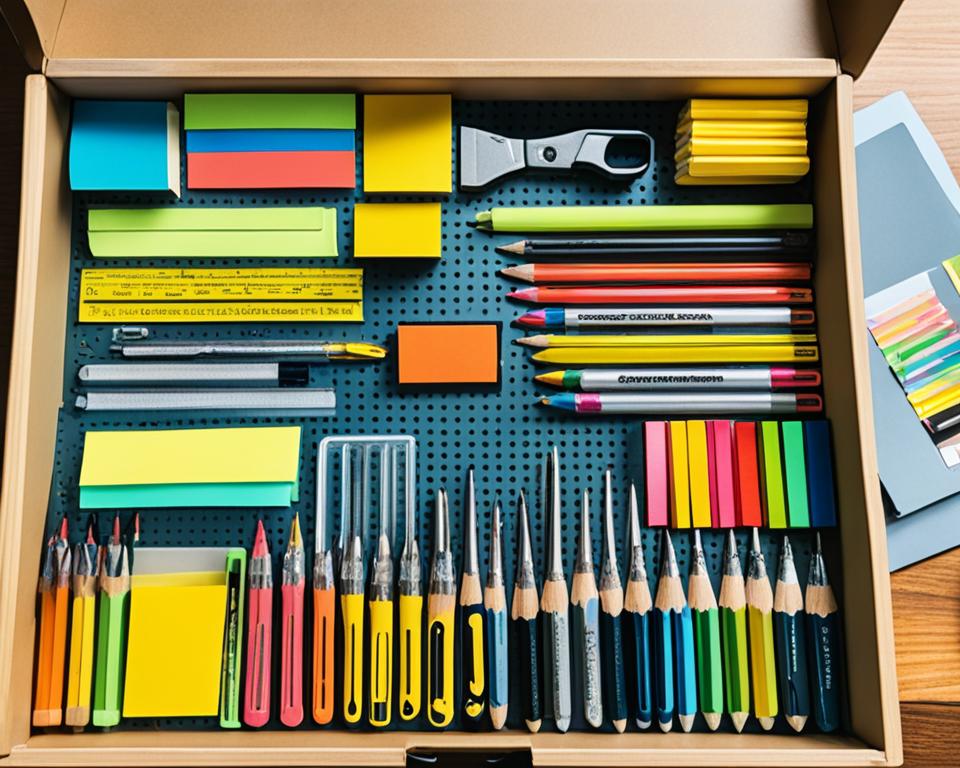
Table: Comparison of Feedback Tools
| Tool | Key Features |
|---|---|
| Google Forms | Creation of surveys and quizzes Customizable feedback forms |
| Flipgrid | Video sharing and feedback Promotes peer-to-peer feedback |
| Screencastify | Screen recording for tutorials and demonstrations Visual and auditory feedback |
| Kaizena | Feedback on Google Docs Text, voice, and video annotations |
Strategies for Feedback
When it comes to providing effective feedback to students, teachers can employ a variety of strategies to ensure clarity, timeliness, and actionable insights. By implementing these feedback strategies, educators can foster a positive and constructive learning environment that promotes growth and development.
Setting Clear Learning Goals
One essential feedback strategy is to establish clear learning goals. By clearly articulating what students should aim to achieve, educators provide a roadmap for success and enable students to self-assess their progress. Clear learning goals help students understand the expected outcomes and enable them to align their efforts accordingly.
Using a Variety of Feedback Methods
Employing a variety of feedback methods can engage students in different ways and cater to diverse learning styles. Teachers can incorporate written feedback, audio recordings, video feedback, and even synchronous discussions to ensure students receive feedback in formats that resonate with them. This variety in feedback methods helps maintain students’ interest and active participation in the learning process.
Providing Timely and Actionable Feedback
Feedback loses its effectiveness if it is not timely or fails to provide actionable insights for improvement. Teachers should strive to deliver feedback promptly, enabling students to reflect on their performance while it is still fresh in their minds. Additionally, feedback should be specific, highlighting areas of strength and suggesting actionable steps for improvement.
Balancing Positive and Constructive Feedback
A successful feedback strategy includes a balance of positive and constructive feedback. While positive feedback reinforces students’ efforts and boosts their confidence, constructive feedback provides guidance for growth. A healthy mix of both types of feedback motivates students and empowers them to strive for excellence.
Encouraging Peer and Self-Feedback
Peer and self-feedback are valuable tools for student growth and development. Encouraging students to provide feedback to their peers and reflect on their own work fosters a sense of ownership over their learning. Peer feedback promotes collaboration, communication, and critical thinking skills, while self-feedback encourages metacognition and self-evaluation.
| Feedback Strategy | Description |
|---|---|
| Setting Clear Learning Goals | Establishing explicit learning objectives to guide students’ efforts and self-assessment. |
| Using a Variety of Feedback Methods | Incorporating diverse feedback formats to cater to different learning styles and maintain student engagement. |
| Providing Timely and Actionable Feedback | Promptly delivering feedback that offers specific insights for improvement. |
| Balancing Positive and Constructive Feedback | Striking a balance between reinforcing students’ efforts and providing guidance for growth. |
| Encouraging Peer and Self-Feedback | Promoting collaboration, communication, and metacognition through peer and self-feedback opportunities. |
Creating Open Channels of Communication
Establishing open channels of communication with students is essential for providing individualized support. By fostering a supportive learning environment, educators can ensure that students feel heard, understood, and valued. This can be achieved through a combination of open communication, temperature checks, virtual home visits, and regular communication.
“Open communication is the key to building trust and fostering meaningful connections with students. It allows educators to understand their students’ needs, challenges, and goals, enabling them to provide tailored support.”
Temperature Checks
Temperature checks are a valuable tool for assessing students’ well-being and gaining insights into their emotional state. Educators can incorporate simple questionnaires or surveys to gauge students’ feelings, concerns, and level of engagement. This information can guide targeted interventions and allow educators to provide appropriate support.
Virtual Home Visits
In a remote learning setting, virtual home visits can help bridge the physical distance and foster a sense of connection. Educators can schedule one-on-one video calls with students to check in, discuss their progress, address any concerns, or simply have casual conversations. Virtual home visits provide an opportunity to understand students’ home environments and create a more empathetic and inclusive learning experience.
Regular Communication
Regular communication is crucial for maintaining a strong rapport with students. Educators can utilize various communication channels, such as email, messaging platforms, or discussion boards, to keep students informed about class updates, assignments, and deadlines. This frequent contact allows for timely feedback, clarification of instructions, and addressing any questions or concerns that students may have.

| Benefits of Open Channels of Communication | Strategies to Implement |
|---|---|
|
|
Normalizing Asking Questions and Seeking Help
Encouraging students to ask questions and seek help is crucial for their academic growth and development. However, many students, especially middle schoolers, can feel hesitant or intimidated when it comes to asking questions in a classroom setting. To create a supportive learning environment, teachers can employ strategies to make questions less intimidating, value question asking, and provide tailored support to meet the needs of middle schoolers.
One effective way to make questions less intimidating is by creating a culture of curiosity and encouraging active participation. Teachers can foster this by welcoming questions, promoting a non-judgmental atmosphere, and emphasizing that asking questions is a valuable part of the learning process. By normalizing the act of asking questions, students will feel more comfortable seeking clarification and engaging in meaningful discussions.
Valuing question asking is essential in building students’ confidence and empowering them to take ownership of their learning. Teachers can demonstrate the importance of questions by actively listening and providing thoughtful responses. Additionally, highlighting the positive impact of questions on learning outcomes can instill a sense of value and motivate students to ask more questions.
“Asking questions allows students to actively participate in their learning journey, grow their knowledge, and develop critical thinking skills.” – Melissa Thompson, Middle School Teacher
Supporting middle schoolers in asking questions and seeking help requires an understanding of their unique needs. Teachers can provide additional guidance by breaking down complex concepts, offering scaffolding strategies, and using relatable examples. By providing targeted support that aligns with the specific challenges faced by middle school students, teachers can foster a sense of competence and encourage a growth mindset.
Embedding a Supportive Environment
Creating an inclusive classroom environment where students feel comfortable seeking help is crucial. Teachers can implement the following strategies to support question asking and seeking help:
- Establish open lines of communication through daily check-ins or virtual office hours.
- Create small group discussions to encourage peer support and collaborative problem-solving.
- Offer anonymous question submission platforms to address privacy concerns and reduce self-consciousness.
By embedding these strategies into their teaching practices, educators can create a positive culture of asking questions and seeking help, empowering middle schoolers to take an active role in their learning journey.
Supporting Visual
“As educators, it is our responsibility to nurture a safe and supportive environment where students feel valued and empowered to seek help without hesitation. By normalizing the act of asking questions, we can instill a lifelong love for learning.” – Jennifer Rodriguez, Middle School Principal
Setting Aside Dedicated Time for Student Support
Allocating dedicated time for students to seek help is essential in a remote learning environment. By offering virtual office hours, face-to-face interaction, small group help, and opportunities to find mentors, educators can provide individualized assistance to their students.
Virtual office hours offer a convenient way for students to connect with their teachers and receive support outside of regular class time. During these designated hours, students can schedule one-on-one virtual meetings or join virtual classrooms to ask questions, seek clarification, or discuss their progress. This direct interaction fosters a sense of connection and allows for personalized guidance and feedback.
Additionally, face-to-face interaction plays a vital role in enhancing student support. Video conferencing platforms enable educators to engage in real-time conversations, create a more personal connection, and address individual needs. By utilizing video calls, teachers can provide immediate assistance, offer explanations, and collaborate with students to find effective solutions.
“Virtual office hours and face-to-face interaction help teachers establish a direct line of communication with their students, providing a safe space for questions and discussions that simulate the in-person classroom experience.”
Small group help is another valuable strategy for supporting students in a remote learning setting. By organizing small group sessions, teachers can address common challenges, facilitate peer collaboration, and encourage students to learn from one another. These focused interactions foster a sense of community, boost engagement, and allow for targeted assistance tailored to the needs of a specific group.
Benefits of Setting Aside Dedicated Time for Student Support
- Enhanced Learning: Dedicated support time allows students to receive personalized guidance and clarification, leading to improved understanding and mastery of the material.
- Individualized Assistance: Virtual office hours, face-to-face interaction, and small group help enable teachers to provide tailored support to meet the specific needs of each student.
- Building Relationships: Regular interaction and support sessions create a sense of trust and connection between educators and students, fostering a positive learning environment.
- Increased Confidence: Students who have access to dedicated support feel more confident in seeking help and addressing challenges, empowering them to take ownership of their learning.
Considering Inequities Faced by Students
Educators have a crucial role in addressing student inequities and providing support for their mental and emotional needs. In a diverse classroom, it is essential to understand and accommodate the unique challenges faced by non-native English speakers and students from disadvantaged backgrounds. By acknowledging these inequities and providing additional learning opportunities, educators can create a more inclusive and supportive learning environment for all students.
Non-native English speakers often face language barriers that can hinder their academic progress. Teachers can implement strategies such as providing bilingual resources, offering language support programs, and incorporating culturally responsive teaching methods. By addressing the specific needs of non-native English speakers, educators can ensure that these students receive equal access to education and opportunities for success.
Disadvantaged students may struggle with various socio-economic, environmental, or personal factors that impact their learning experiences. It is crucial for educators to recognize and support these students by providing additional learning opportunities. This can include organizing after-school programs, offering tutoring or mentorship programs, or collaborating with local organizations to provide resources for students in need. By addressing the specific challenges faced by disadvantaged students, educators can help level the playing field and ensure that all students have equal opportunities to succeed academically.
Catering to Mental and Emotional Needs
In addition to addressing inequities, educators should also prioritize the mental and emotional well-being of their students. Educational environments can be a source of stress and anxiety for many students, especially in the case of remote or online learning. It is crucial for educators to create a safe and supportive space where students feel comfortable sharing their concerns and seeking help.
Implementing strategies such as regular check-ins, emotional support programs, and fostering a sense of belonging can significantly impact students’ mental health. By providing a nurturing environment, educators can ensure that students feel supported and valued, leading to improved academic performance and overall well-being.
Accommodating Students with Disabilities
Teachers play a vital role in ensuring that students with disabilities receive the necessary support in a virtual learning environment. By implementing virtual accommodations and providing individualized support, educators can create an inclusive and accessible space for all students.
One effective strategy is to establish a routine that incorporates minimal technology. This not only helps students with disabilities navigate the virtual platform but also creates a sense of stability and familiarity. By setting clear expectations and incorporating consistent routines, educators can provide a structured and supportive learning environment.
Additionally, it is crucial to offer virtual accommodations that meet the unique needs of students with disabilities. This can include providing alternative formats for instructional materials, such as audio or visual aids, to accommodate different learning styles. Educators can also offer individualized support through virtual conferences or one-on-one sessions to address specific challenges and provide personalized guidance.
Collaboration with specialists and support staff is also key in accommodating students with disabilities. By working closely with professionals such as special education teachers or speech therapists, educators can develop tailored strategies and interventions to address specific needs.
Overall, accommodating students with disabilities requires a combination of virtual accommodations, individualized support, routine, and minimal technology. By implementing these strategies, teachers can create an inclusive learning environment where all students can thrive.
Conclusion
Providing effective feedback and support to students in a remote learning environment is crucial for their success. By implementing the strategies discussed in this article, educators can enhance their remote teaching practices and ensure that students receive the support they need to thrive.
Remote student feedback plays a vital role in guiding students’ progress and helping them understand their strengths and areas for improvement. Teachers can utilize various online tools and platforms to deliver timely and constructive feedback, such as Google Forms, Flipgrid, Screencastify, and Kaizena.
In addition to feedback, virtual student support is essential for creating a supportive learning environment. By establishing open channels of communication with students, teachers can provide individualized assistance through temperature checks, virtual home visits, and regular communication.
Furthermore, it is important to consider the unique challenges that students may face in a virtual learning environment. By accommodating the diverse needs of students, including those with disabilities and non-native English speakers, educators can ensure that every student has access to equitable opportunities for learning and growth.
FAQ
How can I provide feedback and support to students remotely?
There are several strategies and techniques you can use to provide effective feedback and support to students in a remote learning environment. These include setting clear learning goals, using a variety of feedback methods, providing timely and actionable feedback, balancing positive and constructive feedback, encouraging peer and self-feedback, and establishing open channels of communication with students.
What are the types of feedback?
Feedback can be categorized into different types based on its purpose, source, timing, and format. These include formative feedback, summative feedback, positive feedback, and constructive feedback.
What are the benefits of feedback for students?
Feedback has several benefits for students, including boosting their confidence and self-efficacy, linking learning goals to their interests and aspirations, promoting autonomy and ownership, and enhancing engagement and persistence in learning.
What are the challenges of providing feedback in a remote learning environment?
Providing feedback in a remote learning environment can present challenges such as providing timely and frequent feedback, conveying the tone and intention of feedback in written or audio formats, managing overwhelming feedback from multiple sources, and dealing with demotivating or vague feedback.
What tools can I use to provide feedback in a remote learning environment?
There are several tools available for providing feedback in a remote learning environment, including Google Forms for surveys and quizzes, Flipgrid for video sharing and feedback, Screencastify for recording tutorials and demonstrations, and Kaizena for giving feedback on Google Docs using text, voice, or video annotations.
How can I create open channels of communication with students?
Establishing open channels of communication with students is essential for providing individualized support. This can be done through temperature checks, virtual home visits, and regular communication to create a supportive learning environment.
How can I normalize asking questions and seeking help in a remote learning environment?
Encouraging students to ask questions and seek help is crucial. Teachers can create a supportive atmosphere by making questions less intimidating, valuing question asking, and providing support specifically tailored to middle schoolers’ needs.
How can I allocate dedicated time for student support in a remote learning environment?
Allocating dedicated time for students to seek help is essential. Virtual office hours, face-to-face interaction, small group support, and finding mentors can all contribute to providing individualized assistance to students.
How can I consider inequities faced by students in a remote learning environment?
Educators must consider the inequities faced by students and cater to their mental and emotional needs. This includes addressing the needs of non-native English speakers and providing additional learning opportunities for disadvantaged students.
How can I accommodate students with disabilities in a remote learning environment?
Teachers should develop accommodations for students with disabilities to ensure they receive individualized support. Establishing a routine with minimal technology can help create an inclusive learning environment for all students.
How can I provide effective remote student feedback and support?
Providing feedback and support to students remotely requires thoughtful strategies and an understanding of the unique challenges in a virtual learning environment. By implementing the strategies discussed in this article, educators can enhance their remote teaching practices and ensure that students receive the support they need to succeed.

